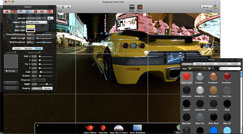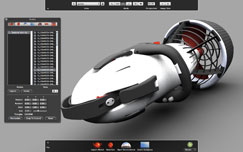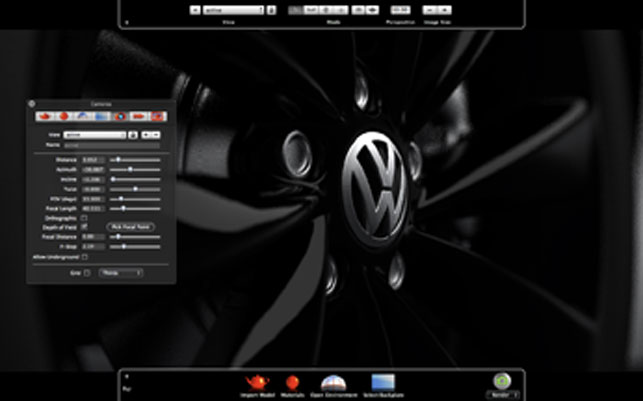Rendering and visualisation have spread far and wide throughout the product development community. From traditional users within the industrial and automotive design field, it is now found throughout mainstream engineering and design.
The ability to visualise a ‘manufactured’ product, before it has got anywhere near the final design stage, is certainly a powerful tool. Design reviews, management and client presentation, and pre-manufacture marketing are all made more rich, engaging and informative if the product can be visualised photo-realistically. The problem is that photorealistic visualisation has traditionally been a complex, time consuming process, both to set-up the rendered scene, with lights, backdrops, materials and textures, and of course to calculate the images and animations.

New fine tuning controls for areas such as Camera provide the ability to dial in effects such as Depth of Field to achieve maximum realism
HyperShot changed this by combining several technologies into a very slick user interface. Firstly, it uses progressive rendering to stream visual data into the display. This means it starts with a very rough image, and then refines each pass until the final render is complete.
Bunkspeed, the developer of HyperShot, isn’t the first or last to use this technology, but it has been the first to achieve wide recognition. Progressive rendering in HyperShot is highly CPU dependent, but very quick on even the most modest of hardware. On the more powerful machines, particularly those with four or more CPU cores, it delivers near real-time performance at lower resolutions.
HyperShot also takes advantage of High Dynamic Range images (HDRi) to provide both lighting for the scene and scene data if required. HDR images allow the capture of much more information about a scene in comparison to standard digital images. They store a richer set of information about the lighting captured in the scene, in terms of luminance, and this results in richer highlights and shadows that more accurately reflect the real world.
In comparison to many of the standalone rendering systems, HyperShot features an impressive range of data translation tools so transferring 3D product models from workhorse CAD systems is much easier. This is done via plug-ins, including Pro/Engineer, SolidWorks Rhino, and SketchUp, or through a variety of standard formats such as IGES, STEP, or OBJ.
HyperShot runs on both Windows and Mac. With the system being picked up by many involved in both the product development and advertising/marketing industry, the ability to have the system running on both platforms, is essential.

Materials editing is now much more slick
Another major part of HyperShot’s success is the user experience. The first release of HyperShot brought a very slick user interface, or more accurately, lack thereof. By combining simple, but sparsely used dialogs, along with keyboard and mouse shortcuts, users can focus on the image they’re creating, rather than juggling complex dialogs and presets found in many rendering tools.
So how has this all changed for the HyperShot ’10 release and is that magic still there? The interface has undergone some radical rework and while the first release didn’t really have one to speak of, this release certainly does. The good news is that it still works in the same way, but users are presented with immediate access to all the options and inputs. It feels fresh and modern on both the Mac and Windows and existing users should find it much friendlier and more intuitive. The two key additions are the Palette and the Library and these are worth exploring in more detail.
The Palette

Found in the new Palette, model structure explorer provides control over how scenes are organised. Combined with the new update geometry, it offers a much more efficient workflow when working with 3D CAD data
The Palette is key. Unlike the last release that spread control of the scene across several dialogs, the new palette provides direct access to everything. The Model tab gives access to a full model tree representation of the scene, which is a welcome addition to this release. It also includes scaling and translation tools. The palette also includes materials editing, environment control over the HDR settings, and backplate, camera controls, animation and display settings.
It’s important to note that beneath these very simple dialogs lies a lot of power. Sliders have been added to assist with fine-tuning settings. This is particularly useful for camera control as rather than relying on in-screen adjustments, precise control over distance, twist and azimuth are possible. Depth of Field (DoF) also benefits greatly from the new dialogs as users can set where and how DoF occurs, adding that extra level of realism.
The library
The library is the second major addition to HyperShot ‘10. It collects together all the materials – which are categorised by type, such as plastics, metals, and decals – plus textures, environments, backplates and renders. All come with full, resizable previews, allowing users to see exactly what they are working with. To use a particular asset, simply drag and drop it into position. For environments, grab the HDR file and drag it into the scene. To assign materials, just drag those onto the relevant parts. Remember, HyperShot has always maintained cross-referenced materials, so materials can be auto assigned to other parts that reference it.
Design reviews, presentations and pre-manufacture marketing are all made more rich, engaging and informative if the product can be visualised photo-realistically
Where the Palette and Library come into their own is when used together with material editing and fine-tuning. When dragging and drop standard materials, the system assigns them and the user can then double click the part and edit the materials details in the palette that pops up. To reuse or store that adapted material, the user simply stores it in the appropriate area category.
Maintaining source links
There are a number of key updates for this release related to working with source data. Firstly, the translation tools to read in CAD geometry have been expanded upon, specifically for the Mac version where STEP and IGES are now supported.
As we’ve already mentioned, the Model Tree display is very handy for controlling the scene and organising data. Another huge bonus is the ability to automatically update geometry. When CAD data is imported the link is maintained so, if there’s a change to the CAD model, the HyperShot scene can be automatically updated with the new geometry. Where possible, materials are reassigned, but parts have been added, the user will need to assign new materials – but it’s much quicker than starting again from scratch, which was required previously.
HDR images can also maintain intelligent links. If an HDR image is edited, HyperShot automatically reloads the source file and updates the scene. HDR editing is a relatively new concept, but with the introduction of tools within Photoshop and more specialised software such as HDR Light Studio, it’s becoming more and more common and can be integrated into the workflow more easily.
Other updates

The new Camera grid, switchable between third, halves and quarters provides visual guidance for image composition. It’s a small enhancement, but it’s surprisingly useful
Alongside these big-ticket items, there are a number of updates worth mentioning. Undo works more consistently and across a wider range of actions, rather than just controlling material changes. There are new ground and camera grids available. The ground grid is useful for positioning separate parts in a scene, while the camera grid helps with composition (and it’s displayable as third, quarters or halves).
Another thing that’s been reworked is the render queue. This is much more usable than in previous releases and provides more feedback about what’s queued and what’s underway. And finally, there’s been SpaceMouse support on both PC and Mac platform.
Conclusion
Right from the off, HyperShot has been an impressive tool and one that is attuned to the process of creating imagery, rather than controlling software. The Mac version has been worked on for this release and while you still haven’t got direct read for SolidWorks and Pro/Engineer data, it can be worked around with standard formats and data can be brought in from almost any 3D system to create stunning imagery.
The updates made to both the UI and things like intelligent linking to source files, previews and drag and drop, all work together to make the system more productive. It works as you would expect, and more so than ever before, but retains that ability to focus directly on making jaw dropping images to aid your product development process.
HyperShot ‘10 represents a leap forward for the system. Not only in terms of functionality, but also in relation to user experience and efficiency.
| Product | HyperShot ‘10 |
|---|---|
| Company name | Bunkspeed |
| Price | From €995 |






